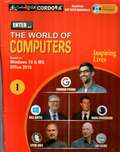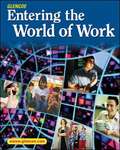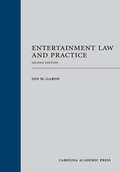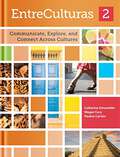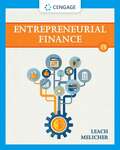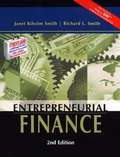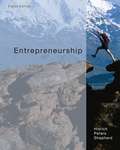- Table View
- List View
English to Use
by Barbara A. Trautman David H. TrautmanWelcome to English to Use. This book includes many of the grammar skill you will need now and later in life. You may be wondering why you should study English grammar. Think about the world around you. When you write, read, or speak, you draw on your knowledge of grammar. Knowing how to write sentences correctly will help you communicate more effectively, both in writing and speaking.
English, 6th Class - Andhra Pradesh Board
by ApscertThis is the prescribed text book for 6th class students for the subject of English language in the state of Andhra Pradesh.
English: Intermediate Language Skills B, Student Pages, Semesters 1 & 2
by Inc. K12NIMAC-sourced textbook
Enjoying Global History
by Henry Abraham Irwin PfefferTo give reluctant readers a basic text that brings history to life, and to provide all readers with a high-interest supplementary resource text.
Enjoying Good Health,Third Edition
by Delores ShimminThe book guides us with effective ways of staying fit and information about nutrition,recipes,exercises and other health tips.
Ensminger's Equine Science (8th Edition)
by M. E. Ensminger C. J. HammerA scientific name is written with the genus name followed by the species name. For example, the horse's scientific name is Equus caballus.
Ente Nattuperuma: എന്റെ നാട്ടു പെരുമ - ഉപന്യാസങ്ങൾ
by Chakshumathi Assistive Technology Centreഎന്റെ നാട്ടു പെരുമ - പ്രാദേശിക ചരിത്ര രചന ഒരു പ്രദേശത്തിന്റെ പ്രാദേശികമായ പ്രത്യേകതകളുടേയും ആ പ്രദേശത്ത് നിലനിന്നിരുന്ന സംസ്കാരങ്ങളേയും കുറിച്ച് വെളിച്ചം വീശുന്നതിലേക്ക് വളരെയധികം സഹായിക്കുന്നു. ആ പ്രദേശത്തെ പഴയകാല വിദ്യാഭ്യാസ സ്ഥാപനങ്ങളുടേയും, കാര്ഷിക വൃത്തി- യുടേയും തനതു സംസ്കാരത്തേയും ജീവിതരീതിയേയുമെല്ലാം കുറിച്ചു പറയുന്നു. 100 വർഷം പിന്നിട്ട പനങ്ങാട് ഗവണ്മെന്റ് വൊക്കേഷണൽ ഹയർ സെക്കണ്ടറി സ്കൂൾ അവരുടെ സെന്റിനറി ആഘോഷങ്ങളുടെ ഭാഗമായി കേരളത്തിലെ സ്കൂൾ കുട്ടികൾക്കായി നടത്തിയ ഉപന്യാസ മത്സരത്തിലെ തിരഞ്ഞെടുത്ത 14 ലേഖനങ്ങൾ.
Enter The World Of Computers: Based on Windows 10 and MS Office 2016 class 1
by Kartikey KumarEnter The World Of Computers, for classes 1 to 8, based on NEP 2020 guidelines, introduces primary and middle school students to the world of Computers and Information Technology in a carefully graded manner. It helps the students see computer as their friend, so that they not only understand but also use it with ease and to their advantage.
Entering the World of Work
by Grady Kimbrell Ben S. VineyardCreated to help students with special needs develop the skills they need to succeed in their careers and in life, Entering the World of Work focuses on career issues, money management, and balancing work and personal life.
Entertainment Law and Practice (2nd Edition)
by Jon M. GaronThis casebook provides a comprehensive survey of the primary entertainment law practice areas, including motion pictures, music, social media, television, and cultural arts. It addresses both the practical aspects of entertainment and the fundamental underpinnings of entertainment law. Built on a solid theoretical basis for each topic, the materials integrate problems and examples of the cutting edge issues transforming entertainment and technology law practice. This casebook is uniquely balanced to address and integrate the need to teach the practitioner's issues with the jurisprudential framework necessary to make the course appropriate to the law school curriculum.
Entra bajo tu propia responsabilidad (¡Arriba la Lectura!, Level G #45)
by Alicia BermejoConoce al aye-aye. Con sus enormes orejas y sus ojos saltones, es uno de los animales más raros que hayas visto. Acompáñalo a conocer otros de los animales más raros, extraños y pecualiares del reino animal. NIMAC-sourced textbook
Entre el suelo y la tierra (¡Arriba la Lectura!, Level Q #45)
by Pamela RushbyNIMAC-sourced textbook
EntreCulturas 1: Communicate, Explore, and Connect Across Cultures
by Ann Mar Robert L. Davis Maritza Sloan George Watson-LópezNIMAC-sourced textbook
EntreCulturas 2 (Spanish Edition)
by Catherine Schwenkler Megan Cory Paulina CarriónSoftcover Student Edition textbook with a 1-year digital subscription to Student Edition FlexText® and Explorer. EntreCulturas 2: Communicate, Explore, and Connect Across Cultures is the second book in a ground-breaking Spanish language and culture textbook series. EntreCulturas 2 is designed for novice to intermediate Spanish learners in middle or high school. This level carefully aligns grammar, vocabulary, and culture with the content introduced and practiced in Level 1, and allows learners to interact with students from different Spanish-speaking countries. There are six units in EntreCulturas 2. EntreCulturas 2, novice-high to intermediate-low, provides: Proficiency-Driven Pedagogy The EntreCulturas series both vertically and horizontally articulates with target proficiency levels. Unit performance goals and essential questions align with the World Readiness Standards; and, formative and integrated performance assessments align with unit goals and essential questions. Activities and learning experiences support each unit s IPA. The sequence of activities and learning experiences move students to the next proficiency level. Students learn grammar and vocabulary through the dialogic and co-constructive strategies. Activities have communicative and intercultural reflections and can-do statements. Authentic, Cultural Understanding Authentic resources are included in each unit, including texts created by Spanish speakers for Spanish speakers. Each unit includes focus on a Spanish-speaking country, like Cuba, Ecuador, or Argentina. Culturally relevant and linguistically authentic activities strengthen the student's confidence, enthusiasm, and interest in the Spanish language and culture, encouraging them to continue to pursue the study of this valuable language and culture. With intercultural can-do statements, students reflect on their own culture and compare it with that they are observing. Preparation for Future Challenges Unlike many other novice to intermediate texts, EntreCulturas 2 introduces AP®/IB themes from the very beginning, setting the tone for not only the SAT in Spanish and the AP® Spanish Language and Culture Exam, but a lifetime of language learning and exploration. Integrated Online Resources Every new copy of EntreCulturas 2 includes a 1-year subscription to the online EntreCulturas 2 Explorer providing students with grammar and vocabulary flashcards, audios, quizzes, discussion forums, as well as many practice and exam activities not found in the book.
EntreCulturas 2: Communicate, Explore, and Connect Across Cultures
by Catherine Schwenkler Megan Cory Paulina CarriónNIMAC-sourced textbook
EntreCulturas 3: Communicate, Explore, and Connect Across Cultures
by Deborah Espitia Pamela García Jennifer Cornell Isabel Vázquez GilNIMAC-sourced textbook
EntreCultures 1: Communicate, Explore, and Connect Across Cultures
by Elizabeth Zwanziger Brittany Goings Hélène Schuster Ed WeissNIMAC-sourced textbook
EntreCultures 4: Communicate, Explore, and Connect Across Cultures
by Elizabeth Zwanziger Ed Weiss Florence Falloux Erin GibbonsNIMAC-sourced textbook
Entrepreneurial Finance
by J. Chris Leach; Ronald W. MelicherMaster each step of the complete ""life cycle"" of a firm with Leach/Melicher's ENTREPRENEURIAL FINANCE, 7E. <p><p>This edition vividly explains the theories, corporate finance tools and techniques you need to start, build and eventually harvest a successful entrepreneurial venture today. Using an inviting presentation, this book emphasizes sound financial management practices as you learn how to secure financing, use business cash flow models and strategically position your early-stage company. You also learn how to interact effectively with financial institutions and regulatory agencies that can impact venture growth and ensure liquidity for investors. <p><p>Updates throughout this edition feature real examples as well as in-depth capstone cases and mini-cases drawn from actual entrepreneurial ventures and common financial scenarios. Strengthen your entrepreneurial skills as you study key concepts, such as venture capital funds, clean tech, sustainable sales growth, strategic alliances, licensing agreements and exit strategies.
Entrepreneurial Finance
by Richard L. Smith Janet Kiholm SmithSmith and Smith apply current thinking in the areas of valuation, real options, and the economics of contracts to new venture decision making. Readers learn to think of new ventures as portfolios of real options, value financial claims of the entrepreneur and venture capital investors, and structure financial contracts in light of new venture information problems. They also learn to use simulation and scenario analysis to evaluate the implications of uncertainty and financial decisions. * Stresses the importance of strategy in new venture planning. * Develops real-world context through relevant examples. * Spreadsheet modeling and simulation using custom software provides hands-on learning.
Entrepreneurial Management in Small Firms
by Dr Ian ChastonExamining the crucial role of innovation and entrepreneurship in achieving growth and ongoing success in the small business sector, this book carefully examines the processes by which small businesses identify new opportunities, evolve appropriate marketing strategies, develop new products and services and successfully launch these into the market.<P> The text:<P> - Includes a dedicated chapter on social entrepreneurship and family firms<P> - Explores issues of Ethics and Corporate Social Responsibility<P> - Packed with supporting "real world" case studies including Apple's iPod, Facebook, Starbucks and YouTube to illustrate how entrepreneurial firms succeed. <P> - Learning features including learning aims, summaries, points for discussion, and further reading. <P> - Companion website with instructors' manual and PowerPoint slides and access to full-text journal articles for students. <P> Visit the Companion website at www.sagepub.co.uk/chaston
Entrepreneurship
by Central Board of Secondary Education The SecretaryThe CBSE's Entrepreneurship curriculum for classes XI and XII, stands out for its strong dynamism, continuous evolution and development. Since 2001, the curriculum has been changed by adopting the functional approach. In the current climate of psychological, social and economic changes, society is influenced by explosive knowledge creation and exponential technology growth. Thus the need to modify and infuse changes in the Entrepreneurship Curriculum at +2 level is a necessary step in the upgradation and updation of the existing curriculum.
Entrepreneurship (8th Edition)
by Robert D. Hisrich Michael P. Peters Dean A. ShepherdThe 8th Edition of Entrepreneurship, by Robert Hisrich, Michael Peters and Dean Shepherd has been designed to clearly instruct students on the process of formulating, planning, and implementing a new venture. Students are exposed to detailed descriptions of 'how to' embark on a new venture in a logical manner. Comprehensive cases at the end of the text have been hand-picked by the authors to go hand-in-hand with chapter concepts. The superb author team of Hisrich, Peters, and Shepherd draw from their distinct backgrounds to create a book that addresses the dynamics of today's entrepreneurial challenges. From Bob Hisrich's expertise in global entrepreneurship to Mike Peter's background as a both a real-life entrepreneur and academic to Dean Shepherd's current research on cognition and entrepreneurial mindset, this book balances the crucial line between modern theory and practice.

